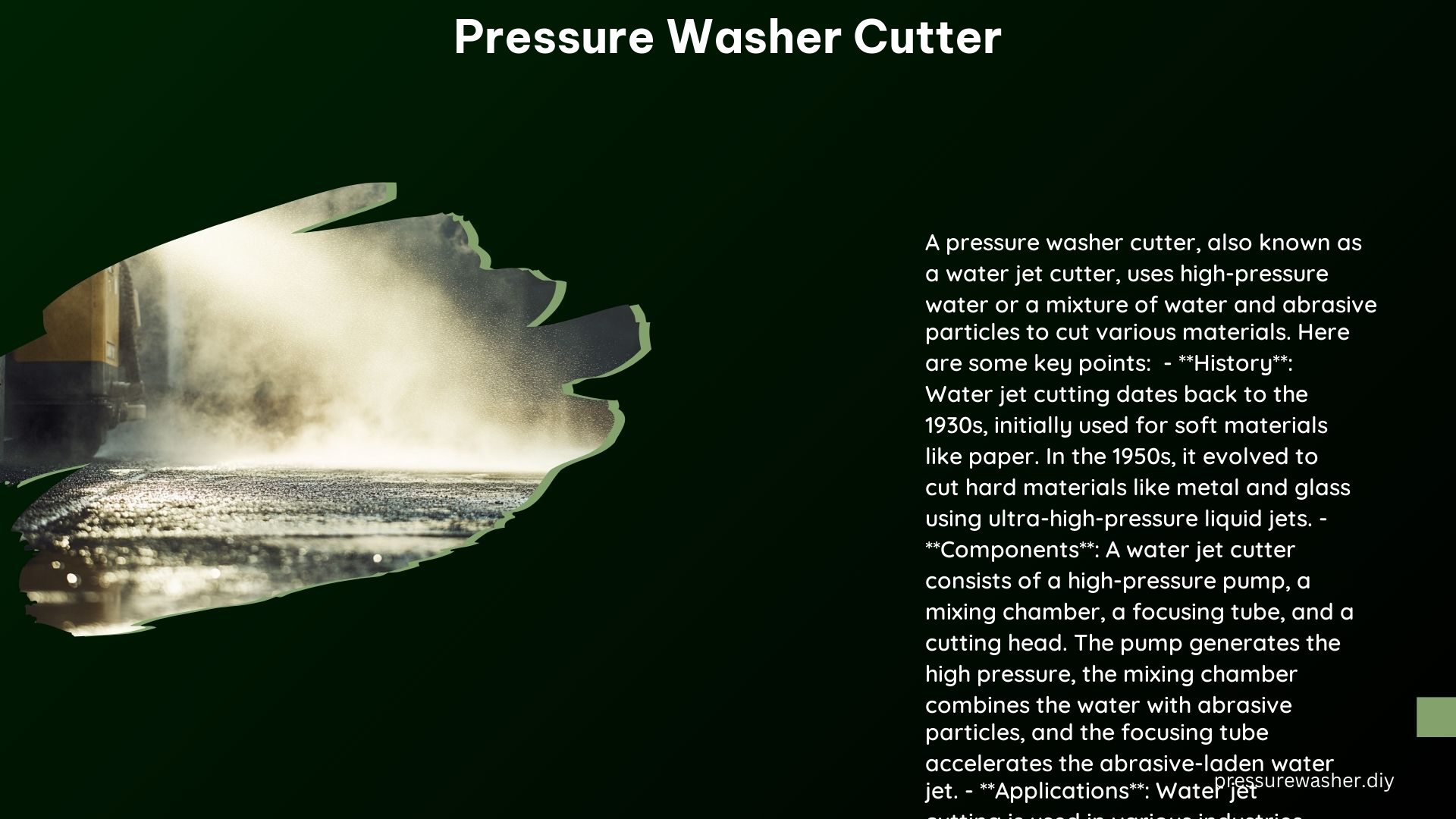A pressure washer cutter, also known as a water jet cutter, is an industrial tool that uses an extremely high-pressure jet of water or a mixture of water and an abrasive substance to cut through a wide range of materials, including metal, stone, glass, wood, rubber, and plastic. This comprehensive guide will delve into the technical specifications, key features, and step-by-step instructions for building your own pressure washer cutter, making it a valuable resource for DIY enthusiasts and industrial users alike.
Key Features and Capabilities
Materials Cut
Water jet cutters are versatile tools that can handle a diverse range of materials, including:
– Metals: Aluminum, steel, titanium, and more
– Stone: Granite, marble, and other natural stones
– Glass: Tempered, laminated, and stained glass
– Wood: Hardwood, softwood, and plywood
– Rubber and Plastics: Gaskets, seals, and various polymer-based materials
High-Pressure Jet
The cutting process involves a high-pressure jet of water or a mixture of water and an abrasive substance, which can reach pressures up to 100,000 psi (690 MPa). This immense pressure is what allows the water jet to effectively cut through even the toughest materials.
Abrasive Water Injector Jet (AWIJ)
The AWIJ method uses a mixing chamber to combine the water jet with abrasive particles, such as garnet, aluminum oxide, or silicon carbide. These abrasive particles are then accelerated and entrained in the direction of the focusing tube, resulting in a high-speed abrasive jet that can cut through even harder materials.
Waterjet Control
Modern waterjet cutting systems employ advanced motion control systems to precisely position the nozzle and specify the speed at every point along the cutting path. This ensures accurate and reliable cutting, allowing for intricate and complex designs to be achieved.
Technical Specifications

Pressure
Commercial water jet cutters typically operate at pressures ranging from 30,000 to 100,000 psi (200 to 690 MPa). This immense pressure is what gives the water jet its cutting power.
Flow Rate
The flow rate of the water jet can vary depending on the application, but typical values range from 1 to 10 gallons per minute (3.8 to 37.9 liters per minute).
Orifice Size
The orifice size determines the width of the cutting jet and can range from 0.003 to 0.018 inches (0.076 to 0.46 mm). Smaller orifice sizes result in a more focused and precise cutting jet, while larger orifices can handle higher flow rates.
Abrasive Material
Common abrasive materials used in water jet cutting include garnet, aluminum oxide, and silicon carbide. The choice of abrasive depends on the material being cut and the desired cutting speed.
Cutting Speed
The cutting speed depends on the material being cut, the pressure and flow rate of the water jet, and the type of abrasive used. Typical cutting speeds range from 1 to 10 inches per minute (2.5 to 25.4 cm/min).
DIY Pressure Washer Cutter
While commercial water jet cutters can be prohibitively expensive, it is possible to build a basic water jet cutter using a pressure washer. By modifying a pressure washer to achieve higher pressures and incorporating abrasive particles, you can create a DIY water jet cutter capable of cutting through a variety of materials.
Example DIY Setup
A $150 pressure washer can be used as the foundation for a DIY water jet cutter. By modifying the pressure washer to reach pressures around 3,200 psi, you can create a system capable of cutting through aluminum and hardwood. The key modifications include:
- Pressure Increase: Upgrading the pump and other components to increase the pressure output of the pressure washer.
- Abrasive Injection: Incorporating an abrasive injection system to mix the water jet with abrasive particles, such as garnet or aluminum oxide.
- Cutting Head Design: Designing a custom cutting head that can focus and direct the high-pressure abrasive water jet.
- Motion Control: Implementing a motion control system to precisely position the cutting head and control the cutting speed.
By following these steps, you can build a functional DIY water jet cutter that can tackle a wide range of materials, all for a fraction of the cost of a commercial system.
Safety Considerations
Working with high-pressure water jets poses significant safety risks, and it is essential to take the necessary precautions when operating a pressure washer cutter.
High-Pressure Injuries
The high-pressure water jet can cause severe injuries, including the injection of microscopic contaminants and organisms deep into the tissue, leading to serious infections and even amputations. Proper safety protocols and personal protective equipment (PPE) are crucial.
Proper Safety Equipment
When operating a pressure washer cutter, it is essential to wear the following safety gear:
– Gloves: Thick, cut-resistant gloves to protect your hands
– Safety Glasses: Shatterproof goggles or a face shield to protect your eyes
– Protective Clothing: Long sleeves and pants to cover exposed skin
By following these safety guidelines and taking the necessary precautions, you can safely operate a DIY pressure washer cutter and enjoy the benefits of this versatile and powerful tool.
